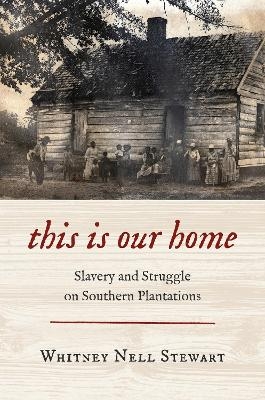
This Is Our Home
Slavery and Struggle on Southern Plantations
Seiten
2023
The University of North Carolina Press (Verlag)
978-1-4696-7568-8 (ISBN)
The University of North Carolina Press (Verlag)
978-1-4696-7568-8 (ISBN)
Insightfully reading the built environment of plantations, considering artifact fragments found in excavations of slave dwellings, and drawing on legal records and plantation owners’ papers, Whitney Nell Stewart illuminates how enslaved people struggled to make home amid innumerable constraints and obstacles imposed by white southerners.
The cultural memory of plantations in the Old South has long been clouded by myth. A recent reckoning with the centrality of slavery to the US national story, however, has shifted the meaning of these sites. Plantations are no longer simply seen as places of beauty and grandiose hospitality; their reality as spaces of enslavement, exploitation, and violence is increasingly at the forefront of our scholarly and public narratives. Yet even this reckoning obscures what these sites meant to so many forced to live and labor on them: plantations were Black homes as much as white.
Insightfully reading the built environment of plantations, considering artifact fragments found in excavations of slave dwellings, and drawing on legal records and plantation owners' papers, Whitney Nell Stewart illuminates how enslaved people struggled to make home amid innumerable constraints and obstacles imposed by white southerners. By exploring the material remnants of the past, Stewart demonstrates how homemaking was a crucial part of the battle over slavery and freedom, a fight that continues today in consequential confrontations over who has the right to call this nation home.
The cultural memory of plantations in the Old South has long been clouded by myth. A recent reckoning with the centrality of slavery to the US national story, however, has shifted the meaning of these sites. Plantations are no longer simply seen as places of beauty and grandiose hospitality; their reality as spaces of enslavement, exploitation, and violence is increasingly at the forefront of our scholarly and public narratives. Yet even this reckoning obscures what these sites meant to so many forced to live and labor on them: plantations were Black homes as much as white.
Insightfully reading the built environment of plantations, considering artifact fragments found in excavations of slave dwellings, and drawing on legal records and plantation owners' papers, Whitney Nell Stewart illuminates how enslaved people struggled to make home amid innumerable constraints and obstacles imposed by white southerners. By exploring the material remnants of the past, Stewart demonstrates how homemaking was a crucial part of the battle over slavery and freedom, a fight that continues today in consequential confrontations over who has the right to call this nation home.
Whitney Nell Stewart is assistant professor of history at the University of Texas at Dallas.
| Erscheinungsdatum | 18.10.2023 |
|---|---|
| Zusatzinfo | 40 photos, 1 map |
| Verlagsort | Chapel Hill |
| Sprache | englisch |
| Maße | 155 x 235 mm |
| Gewicht | 272 g |
| Themenwelt | Sachbuch/Ratgeber ► Geschichte / Politik ► Regional- / Landesgeschichte |
| Geisteswissenschaften ► Geschichte ► Allgemeine Geschichte | |
| Geisteswissenschaften ► Geschichte ► Regional- / Ländergeschichte | |
| Sozialwissenschaften ► Ethnologie | |
| Sozialwissenschaften ► Soziologie ► Makrosoziologie | |
| ISBN-10 | 1-4696-7568-4 / 1469675684 |
| ISBN-13 | 978-1-4696-7568-8 / 9781469675688 |
| Zustand | Neuware |
| Informationen gemäß Produktsicherheitsverordnung (GPSR) | |
| Haben Sie eine Frage zum Produkt? |
Mehr entdecken
aus dem Bereich
aus dem Bereich
Russen und Ukrainer vom Mittelalter bis zur Gegenwart
Buch | Softcover (2023)
C.H.Beck (Verlag)
18,00 €
von der Staatsgründung bis zur Gegenwart
Buch | Softcover (2023)
C.H.Beck (Verlag)
12,00 €
eine Geschichte der Vereinigten Staaten von 1950 bis heute
Buch | Hardcover (2024)
Klett-Cotta (Verlag)
35,00 €


